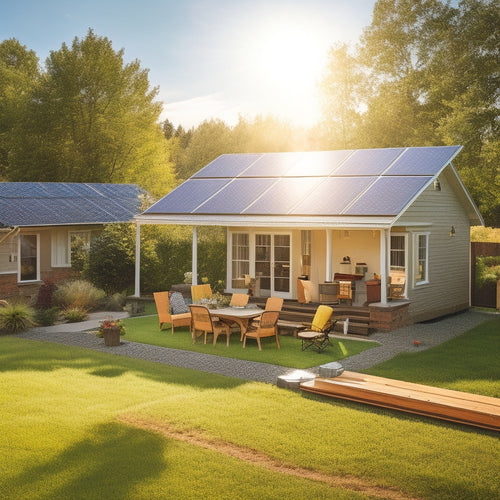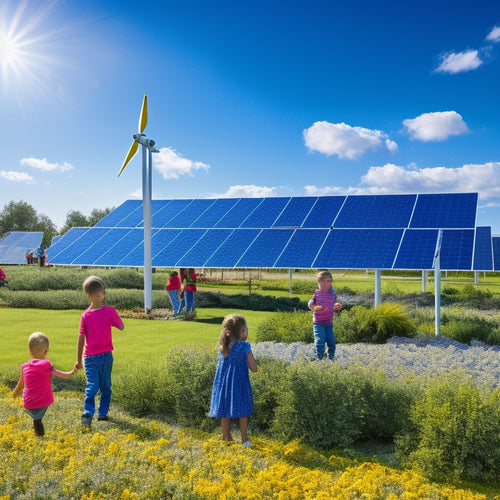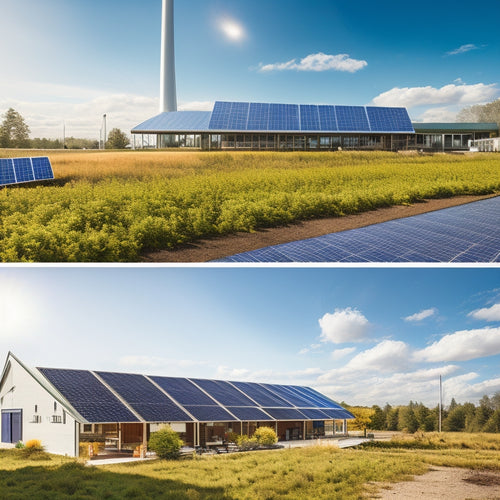
Installing Business PV Systems: A Cost Breakdown Guide
Share
When installing a business PV system, understanding the costs involved is essential for a successful project. System design and engineering costs account for 5-10% of the total expenditure, covering expertise for ideal system integration and energy efficiency. Permitting and inspection fees range from $2,000 to $5,000. Equipment and material expenses make up 60-70% of the total cost, with high-quality panels generating more power per unit area. As you navigate these costs, consider the specifics of your project and explore the incentives available to maximize your return on investment - there's more to uncover as you plan your business PV system.
Key Takeaways
• System design and engineering costs account for 5-10% of the total project expenditure, covering expertise for ideal system integration and energy efficiency.
• Permitting and inspection fees range from $2,000 to $5,000 on average, and vary across different jurisdictions.
• Equipment and material expenses are the largest cost, accounting for 60-70% of the total expenditure, and depend on the quality of solar panels and battery options.
• Mounting costs vary depending on the type of mounting option chosen, with roof mounting costs ranging from $1.50 to $3.00 per watt and ground mounting costs ranging from $2.00 to $4.00 per watt.
• Financial incentives like the Solar Investment Tax Credit (ITC) and local rebates can significantly offset the initial investment for a business PV system.
System Design and Engineering Costs
When designing a photovoltaic (PV) system, you'll need to budget for system design and engineering costs, which typically account for 5-10% of the total project expenditure. These costs cover the expertise required to guarantee ideal system integration, energy efficiency, and performance.
You'll need to take into account the complexity of your system's design, including the type and number of panels, inverters, and mounting structures. A well-designed system will maximize energy production while minimizing costs.
A professional engineer will assess your building's energy needs, roof layout, and local building codes to create a customized system design. This upfront investment will pay off in the long run, as a well-engineered system will reduce maintenance costs and optimize energy efficiency.
Permitting and Inspection Fees
With a well-engineered system design in place, you'll need to secure the necessary permits and undergo inspections to guarantee your PV system meets local building codes and regulations, which will add to your overall project expenditure.
When maneuvering the permitting process, be prepared to face Municipal Hurdles, such as varying fees and timelines across different jurisdictions. Bureaucratic Delays can also arise from incomplete or inaccurate submissions, so it's essential to verify accuracy and thoroughness when submitting your application.
On average, permitting and inspection fees can range from $2,000 to $5,000, depending on the complexity of your project and the locale. Factor these costs into your budget to avoid surprise expenses down the line.
Equipment and Material Expenses
You'll need to factor in the largest expense in your PV system project: equipment and material costs, which typically account for 60% to 70% of the total expenditure. Here, you'll need to evaluate the quality of solar panels, which can greatly impact your system's efficiency. High-quality panels with higher efficiencies will cost more, but they'll also generate more power per unit area.
Additionally, you'll need to decide on battery options, such as deep cycle batteries or lithium-ion batteries, each with their own advantages and price points. Be sure to research and compare prices from different suppliers to get the best deal.
Roof and Ground Mounting Costs
Now that you've selected your equipment and materials, it's time to contemplate the costs associated with securing your PV system to your roof or installing it on the ground.
You'll need to ponder the mounting options that suit your business's specific needs. Roof-mounted systems typically require more labor and materials, increasing costs. Ground-mounted systems, on the other hand, need a larger area and may require additional infrastructure.
Before installation, you'll need to conduct structural assessments to confirm that your roof or ground can support the system's weight. These assessments can add to the overall cost, but they're essential for a safe and efficient installation.
On average, you can expect to pay between $1.50 and $3.00 per watt for roof mounting and $2.00 to $4.00 per watt for ground mounting.
Inverter and Electrical Costs
Your inverter and electrical components play an essential role in converting DC power from your PV system into usable AC power, and their costs can vary greatly depending on the specific requirements of your business's system. The inverter's efficiency, in particular, has a significant impact on your system's overall performance.
When selecting an inverter, consider the following factors that affect cost:
-
Inverter Sizing: A larger inverter may be necessary for systems with high energy demands, increasing costs.
-
Electrical Efficiency: Higher efficiency inverters may be more expensive, but they can reduce energy losses and increase overall system efficiency.
-
String Inverters vs. Microinverters: String inverters are often more cost-effective, but microinverters provide more flexibility and monitoring capabilities.
-
Monitoring and Tracking Systems: Additional features for monitoring and tracking system performance can add to overall costs.
-
Component Compatibility: Ensuring compatibility with other system components, such as trackers and mounting systems, is important to avoid additional costs.
Installation Labor and Overhead
As you navigate the installation process, you'll need to take into account labor costs, which can vary depending on factors like location, system size, and installer expertise.
You'll also need to factor in overhead expenses, such as permits, inspections, and project management fees, which can add up quickly.
Labor Costs Breakdown
You'll need to factor in labor costs, which typically account for 10-20% of the total PV system cost, and are broken down into installation labor and overhead expenses. Labor costs can vary depending on factors like location, workforce dynamics, and labor laws.
Here are some key considerations for installation labor costs:
-
Workforce experience and certification: More experienced and certified workers may command higher hourly rates.
-
Labor laws and regulations: Compliance with local labor laws and regulations can impact labor costs.
-
Project complexity: More complex projects may require specialized labor and higher labor costs.
-
Location and logistics: Labor costs can vary depending on the location and logistics of the project.
-
Overtime and shift differentials: Overtime and shift differentials can increase labor costs.
Overhead Expenses Allocation
Allocate a portion of your installation labor costs to overhead expenses, which encompass a range of indirect costs associated with running a business. These expenses include rent or mortgage payments for your office space, utilities, insurance, and other operational costs.
When planning your financials, it's crucial to allocate a percentage of your labor costs to overhead expenses to guarantee accurate financial planning. Typically, this percentage ranges from 10% to 20% of your total labor costs.
Monitoring and Maintenance Fees
As you consider the overall cost of your business PV system, you'll need to factor in monitoring and maintenance fees. These costs will guarantee your system is running efficiently and effectively, and will typically include system performance tracking, scheduled maintenance costs, and repair and replacement fees.
System Performance Tracking
Your system's performance tracking is essential to guarantee maximum energy production, and this typically requires a subscription to a monitoring service, which incurs ongoing fees. These services provide real-time data analytics to maintain your system operates at peak energy efficiency. By monitoring your system's performance, you can identify potential issues before they become major problems, reducing downtime and lost energy production.
Here are some key features to expect from a monitoring service:
- Real-time monitoring of system performance
- Data analytics to identify trends and anomalies
- Customizable alerts for system issues or performance degradation
- Remote monitoring and troubleshooting capabilities
- Integration with existing energy management systems
Scheduled Maintenance Costs
You'll need to budget for recurring scheduled maintenance costs, including monitoring and maintenance fees, to guarantee your PV system operates at peak performance levels. These costs help to make sure your system is regularly inspected, cleaned, and optimized to maximize energy efficiency.
Predictive analytics can help identify potential issues before they become major problems, reducing downtime and increasing overall system reliability.
Regular monitoring and maintenance also enable you to identify opportunities to improve energy efficiency, reducing your energy bills and environmental impact.
Repair and Replacement Fees
In addition to routine maintenance, budgeting for repair and replacement fees is essential to ensure that your PV system remains in peak working condition. You'll want to take into account the costs associated with fixing or replacing components that fail or deteriorate over time.
Some key factors to take into account when budgeting for repair and replacement fees include:
-
Warranty coverage: Understanding the scope and duration of your warranty can help you plan for potential repair and replacement costs.
-
Extended guarantees: Weighing the benefits of extended guarantees against the additional cost can help you make an informed decision.
-
Component lifespan: Knowing the average lifespan of system components can help you anticipate when replacements may be needed.
-
Labor costs: Factoring in the cost of labor for repairs and replacements can help you budget accurately.
-
System downtime: Calculating the cost of system downtime can help you prioritize repairs and replacements to minimize losses.
Electrical Infrastructure Upgrades
Upgrading the electrical infrastructure is necessary when the existing system cannot support the added power requirements of a PV system, and this upgrade can involve replacing or modifying the main electrical service panel, transformers, and conductors. You'll need to conduct a load analysis to determine the maximum power requirements of your business, and then perform capacity planning to guarantee the upgraded infrastructure can support the increased load. This upgrade can be a significant cost component of your PV system installation.
| Component | Upgrade Cost | Description |
|---|---|---|
| Main Service Panel | $5,000 - $10,000 | Upgrade or replacement of the main electrical service panel |
| Transformers | $3,000 - $6,000 | Upgrade or replacement of transformers to support increased power requirements |
| Conductors | $2,000 - $4,000 | Upgrade or replacement of electrical conductors to support increased power requirements |
Land and Roof Lease Costs
After confirming that your electrical infrastructure can support the added power requirements, you're ready to secure a suitable location for your PV system, which may involve leasing land or rooftop space. This step is essential, as it directly impacts your system's performance and overall costs.
When it comes to land and roof lease costs, consider the following factors:
-
Land acquisition costs: These vary depending on the location, size, and zoning regulations.
-
Roof depreciation: Calculate the reduced roof lifespan due to PV system installation and factor in replacement costs.
-
Lease duration and terms: Negotiate a favorable lease agreement that aligns with your business goals.
-
Rooftop access and maintenance: Ensure easy access for maintenance and repairs to minimize downtime.
-
Insurance and liability: Consider insurance premiums and liability coverage for the leased land or rooftop space.
Local Incentives and Rebates
You can greatly reduce the upfront costs of your business PV system by taking advantage of local incentives and rebates, which vary widely depending on your location and the type of system you're installing. These incentives can include tax credits, government programs, and utility rebates that can meaningfully offset your initial investment.
For instance, the Solar Investment Tax Credit (ITC) allows you to claim a credit of up to 30% of your total system cost. Additionally, many states and utilities offer performance-based incentives, such as feed-in tariffs or renewable energy certificates, which can provide ongoing revenue streams.
Frequently Asked Questions
Can I Install a PV System Myself to Save on Labor Costs?
"You can try installing a PV system yourself to save on labor costs, but be prepared to tackle DIY challenges and navigate Local permits, which can be time-consuming and require specific expertise."
How Long Does a Typical Commercial PV System Last?
'When you're in it for the long haul, a typical commercial PV system lasts around 25-30 years, but with regular system maintenance and warranty options, you can guarantee it runs smoothly and efficiently throughout its lifespan.'
Are Energy Storage Systems Compatible With PV Systems?
You'll find that energy storage systems are indeed compatible with PV systems, allowing you to optimize energy usage and achieve Grid Parity; proper System Sizing is vital to guarantee seamless integration and maximize efficiency.
What Happens to Excess Energy Generated by the PV System?
'As the PV system's energy harvest overflows, you're likely wondering what happens to the excess. Through grid synchronization, you can feed it back into the grid, effectively 'banking' energy credits, which can be redeemed when needed, thanks to energy banking.'
Can I Relocate a PV System if I Move to a New Location?
You can relocate your PV system if you move to a new location, thanks to its inherent system portability and location flexibility, allowing you to take advantage of your investment at your new site.
Related Posts
-

Steps to Prepare for Solar Installation
To prepare for solar installation, start by evaluating your current energy consumption and future needs to determine ...
-

Solar Power for Community Energy Independence
Solar power is essential for your community's energy independence, offering both environmental and economic benefits....
-

Off-Grid Solar Solutions for Eco-Conscious Businesses
Off-grid solar solutions offer you a path to both sustainability and substantial cost savings. By adopting these syst...


